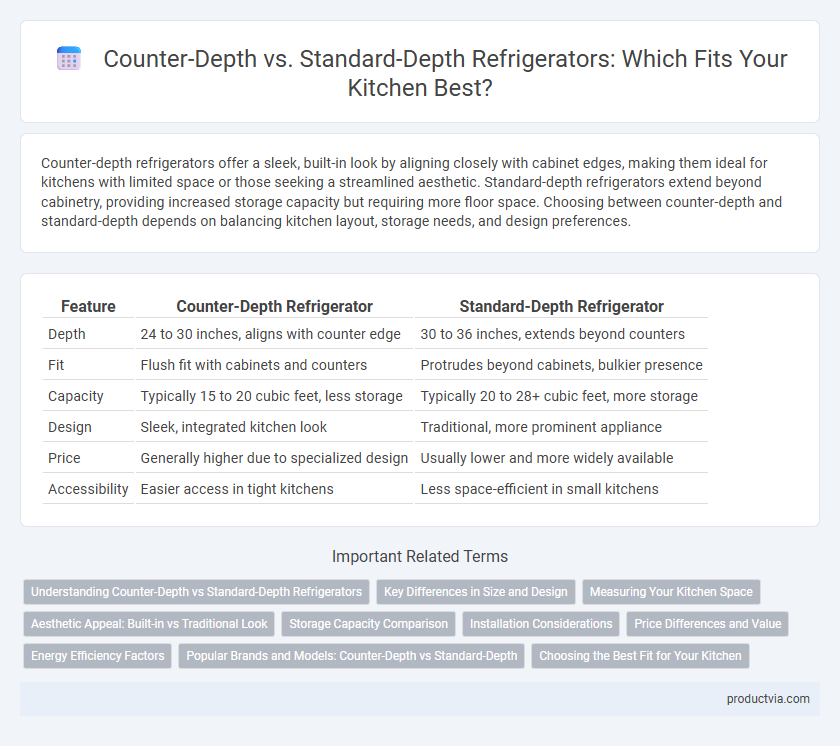Counter-depth refrigerators offer a sleek, built-in look by aligning closely with cabinet edges, making them ideal for kitchens with limited space or those seeking a streamlined aesthetic. Standard-depth refrigerators extend beyond cabinetry, providing increased storage capacity but requiring more floor space. Choosing between counter-depth and standard-depth depends on balancing kitchen layout, storage needs, and design preferences.
Table of Comparison
| Feature | Counter-Depth Refrigerator | Standard-Depth Refrigerator |
|---|---|---|
| Depth | 24 to 30 inches, aligns with counter edge | 30 to 36 inches, extends beyond counters |
| Fit | Flush fit with cabinets and counters | Protrudes beyond cabinets, bulkier presence |
| Capacity | Typically 15 to 20 cubic feet, less storage | Typically 20 to 28+ cubic feet, more storage |
| Design | Sleek, integrated kitchen look | Traditional, more prominent appliance |
| Price | Generally higher due to specialized design | Usually lower and more widely available |
| Accessibility | Easier access in tight kitchens | Less space-efficient in small kitchens |
Understanding Counter-Depth vs Standard-Depth Refrigerators
Counter-depth refrigerators typically measure 24 to 30 inches deep, allowing them to align more closely with kitchen cabinetry for a streamlined look, while standard-depth models range from 30 to 36 inches deep, offering greater storage capacity but protruding beyond cabinets. Choosing between counter-depth and standard-depth depends on kitchen space, desired aesthetics, and storage needs, with counter-depth favoring design integration and standard-depth prioritizing maximum internal volume. Understanding these dimensions is crucial for ensuring proper refrigerator fit and maintaining optimal kitchen flow.
Key Differences in Size and Design
Counter-depth refrigerators typically measure around 24 to 30 inches deep, aligning closely with standard countertop depths for a seamless kitchen appearance, while standard-depth models usually range from 30 to 36 inches deep, offering significantly more storage space. The reduced depth of counter-depth refrigerators means less interior capacity but a cleaner, built-in look, ideal for kitchens where space and aesthetics are priorities. Standard-depth refrigerators protrude beyond cabinetry, providing greater volume and flexibility for families needing additional food storage.
Measuring Your Kitchen Space
Measuring your kitchen space accurately is crucial when choosing between counter-depth and standard-depth refrigerators to ensure proper fit and functionality. Counter-depth models typically extend about 24 to 30 inches from the wall, aligning more closely with countertops for a streamlined appearance, while standard-depth refrigerators usually measure around 30 to 36 inches deep, offering greater storage capacity but potentially protruding into the kitchen walkway. Precise measurements of width, depth, and clearance space, including door swing areas, are essential to optimize appliance placement and maintain kitchen flow.
Aesthetic Appeal: Built-in vs Traditional Look
Counter-depth refrigerators offer a sleek, built-in appearance that aligns flush with surrounding cabinetry, enhancing kitchen aesthetics with a streamlined, modern look. Standard-depth refrigerators protrude beyond the cabinets, creating a traditional, bulkier presence that can disrupt the visual flow of the kitchen. Opting for counter-depth models significantly contributes to a cohesive and minimalist design, appealing to homeowners prioritizing style and seamless integration.
Storage Capacity Comparison
Counter-depth refrigerators typically offer 15-20% less storage capacity than standard-depth models due to their shallower design, which aligns more closely with cabinetry for a streamlined kitchen look. Standard-depth refrigerators provide larger interior volumes, often exceeding 25 cubic feet, making them ideal for families needing maximum storage for fresh and frozen items. Homeowners must weigh the trade-off between aesthetic integration and the need for ample food storage when choosing between these refrigerator depths.
Installation Considerations
Counter-depth refrigerators typically require less clearance for installation due to their shallower design, fitting more seamlessly with kitchen cabinetry and countertops. Standard-depth refrigerators often need additional space for ventilation and door clearance, which can affect placement and accessibility in smaller kitchens. Proper measurement of existing cabinets and door swing areas is essential to ensure optimal fit and function during installation.
Price Differences and Value
Counter-depth refrigerators typically cost 10-20% more than standard-depth models due to their sleek design and space-saving features. Standard-depth refrigerators offer greater storage capacity at a lower price, making them ideal for larger families or budget-conscious buyers. The value of a counter-depth model lies in its ability to seamlessly integrate with cabinetry, enhancing kitchen aesthetics while sacrificing some storage space.
Energy Efficiency Factors
Counter-depth refrigerators generally consume less energy due to their smaller size and reduced interior volume, which requires less cooling power compared to standard-depth models. Standard-depth refrigerators, while offering greater storage capacity, often have higher energy consumption because of their larger surface area that demands more frequent cooling cycles. Energy Efficiency Ratings such as ENERGY STAR certification can help consumers compare models and choose the optimal refrigerator fit based on power use and space requirements.
Popular Brands and Models: Counter-Depth vs Standard-Depth
Counter-depth refrigerators from popular brands like Samsung, LG, and KitchenAid offer a sleek, built-in look by aligning flush with cabinetry, typically measuring 24 to 30 inches deep. Standard-depth models, such as those from Whirlpool, GE, and Frigidaire, provide larger storage capacity with depths around 30 to 36 inches, projecting beyond countertops for maximum space. Choosing between counter-depth and standard-depth depends on kitchen layout preferences and desired storage volume, with key models including the Samsung Family Hub (counter-depth) and Whirlpool WRF535SWHZ (standard-depth).
Choosing the Best Fit for Your Kitchen
Counter-depth refrigerators offer a sleek, built-in look by aligning flush with cabinetry and walls, ideal for kitchens with limited space or streamlined design preferences. Standard-depth models provide greater storage capacity, extending beyond countertops and fitting well in larger kitchens where maximum food storage is a priority. Selecting the best fit depends on balancing kitchen layout, storage needs, and aesthetic goals to optimize both functionality and visual appeal.
Counter-depth vs standard-depth for refrigerator fit Infographic

 productvia.com
productvia.com